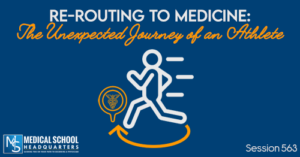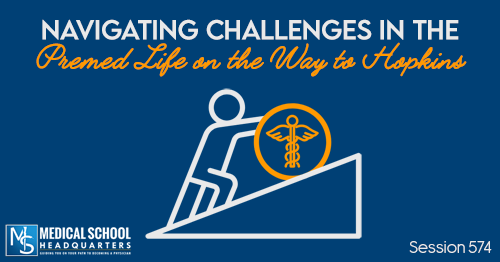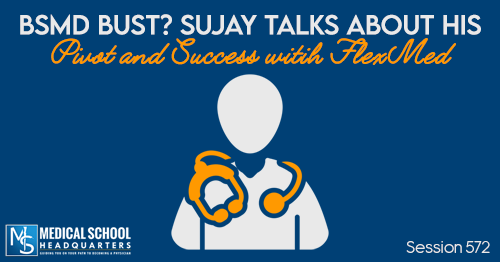Apple Podcasts | Google Podcasts
Session 563
This episode is about JR’s journey through premed, medical school, and becoming a content creator with his YouTube channel Evolving Medic. JR talks about balancing medical school, family life as a father, and creating online content.
For more podcast resources to help you with your medical school journey and beyond, check out Meded Media.
Listen to this podcast episode with the player above, or keep reading for the highlights and takeaway points.
JR’s Unexpected Path to Medicine
JR did not always plan to become a doctor. As a track athlete at Duke University, he intended to pursue a career in athletics. However, a knee injury during his freshman year introduced him to the world of orthopedic surgery. He found himself fascinated by the medical professionals who helped treat his injury.
Though the injury derailed his athletic dreams, it set JR on an unexpected path towards medicine. He decided to change his major to fulfill premed requirements while recovering from surgery. With guidance from his orthopedist mentor, JR gained exposure to the medical field through shadowing and research opportunities.
Despite some early academic struggles adjusting to premed coursework, JR persevered. He improved his study skills over time and achieved success on the MCAT and in his medical school applications. JR’s story shows how an injury can inspire an alternate career path. It also demonstrates his dedication in overcoming challenges through hard work and mentorship.
Finding Guidance Through Mentorship
Early in his journey, JR recognized the importance of mentorship. When deciding to pursue medicine after his knee injury, he sought advice from his orthopedic surgeon. This surgeon not only performed JR’s surgeries but also actively mentored premed students at Duke University.
Benefits of Seeking Mentorship
JR benefited tremendously from his surgeon’s guidance and connections. He was able to shadow both his mentor and other physicians, gaining valuable exposure to the medical field. This helped JR confirm his interest in becoming a doctor. The mentor also steered JR towards resources like his premed advisors to ensure he took the right classes.
As JR progressed in the application process, he continued cultivating mentor relationships. He shadowed an orthopedist in Colorado through connections from his initial mentor. These mentors supported JR’s medical school applications and gave him research and shadowing opportunities during his gap years.
JR’s story shows how impactful mentorship can be for premed students. By proactively seeking guidance, he was able to navigate the path to medicine. JR now pays it forward through his own mentoring of future physicians as a content creator and medical student.
How to Find a Mentor
JR shared valuable tips for finding mentors based on his own successful experiences. Students should first reach out to physicians they interact with through treatment, shadowing, or other opportunities. Express interest in their field and ask how they became a doctor. Physicians can also be researched online through websites, publications, and social media profiles, looking for those engaged in mentorship.
Personalized messages should be sent showing understanding of their work while highlighting any shared interests or ways to support their goals. Do not get discouraged by a lack of initial response, as networking takes diligence. Consider respectfully cold messaging physicians on social media if their specific work and career path can be demonstrated as interesting.
Learning to Handle Rejection
All that being said, it’s less about being comfortable with making initial outreach attempts, and more about being comfortable with the rejection that often results from it.
Most mentorship requests will go unanswered, and some physicians may outright say no. But rejection shouldn’t deter students, as persistence and dealing with rejection is what eventually leads to success. Learning to handle rejection with poise and perseverance is an important part of effectively networking for mentorship opportunities.
Mentorship is a Two-Way Street
JR emphasized that mentorship is a two-way street that requires effort on both sides. When initially reaching out cold, students need to show genuine interest in learning about the mentor as an individual beyond just what they can provide.
“Mentorship is like a two-way street.”
Personalizing outreach by demonstrating knowledge of a mentor’s specific work, research interests, or career path will increase the likelihood of a response. Mentors want to feel their time and guidance is valued, so students must communicate how they may be able to support the mentor’s own goals through the relationship as well. Approaching mentorship as a mutual opportunity for growth and contribution, rather than just taking from the mentor, helps establish effective long-term partnerships.
Overcoming Early Struggles: JR’s Path to Med School Acceptance
JR did not have the traditional premed academic journey. As a track athlete at Duke majoring in evolutionary anthropology, he initially took premed courses with no intention of applying to medical school. But a knee injury as a freshman introduced him to orthopedic surgery and sparked his interest in becoming a doctor.
Transitioning to the premed track was not without challenges. JR struggled in his first organic chemistry and biochemistry courses, earning C’s that lowered his science GPA (3.2). However, he was determined to improve and fine-tuned his study skills over time. By junior and senior year, JR was achieving success comparable to his peers.
Preparing for the MCAT also required perseverance. JR took the exam twice – scoring a 506 the first time but not feeling fully prepared. With focused study, he improved to a 511 on his second attempt. These scores, along with his upward academic trend, demonstrated to medical schools that JR could handle their rigorous curriculum.
Despite some early setbacks adapting to premed coursework, JR’s story shows the importance of not giving up. Through hard work refining his learning strategies and re-taking the MCAT, he overcame initial struggles to achieve acceptance into medical school. JR’s journey proves that with dedication, students can overcome less-than-ideal academic starts.
How JR Benefited from Two Gap Years Before Medical School
JR took two gap years between completing his undergraduate degree and matriculating to medical school. During this time, he gained valuable experience that strengthened his application.
The first year was dedicated to MCAT preparation and retaking the exam. This allowed JR to boost his score significantly. The second gap year was spent doing orthopedic research with Dr. McCarty at a sports medicine clinic in Colorado.
Through this research experience, JR was able to deepen his interest in orthopedics and learn first-hand about the field he wished to enter. He also used the time to refine his personal statement and put together the best possible application package.
Taking two years off proved beneficial for JR, as he only needed to apply to medical school once to secure an acceptance. The gap years provided focused time to address weaknesses in his application. It also allowed him to engage in meaningful activities that demonstrated his commitment to orthopedics to admissions committees.
Sharing His Story to Inspire Others: Why JR Founded Evolving Medic
When JR began his journey through medical school, he noticed a lack of diversity among the many YouTube influencers sharing their experiences. As one of the few Black male medical students, JR wanted to provide a perspective that students from underrepresented backgrounds could relate to. He launched his YouTube channel Evolving Medic to document his path through school and residency applications.
JR’s goal was to help more students envision themselves succeeding in medicine. He hoped that by putting his story out there, others who didn’t see themselves represented would feel they too could achieve their dreams of becoming a doctor. Starting the channel during his interviews helped JR connect with students and gain confidence in his own abilities from their positive feedback.
As Evolving Medic grew, JR was motivated to keep creating content by the students who said he contributed to their understanding and success. He expanded to additional platforms like podcasts and newsletters to reach broader audiences. JR continues sharing his journey in order to educate and inspire as many future physicians as possible, especially those from minority backgrounds. His story shows how personal experiences can motivate increasing diversity in the medical field.
More than Just Stats: The Importance of “Fit”
JR discusses the importance of fit in medical school admissions, beyond just stats and numbers. As someone who served on an admissions committee, he emphasized that schools are looking for applicants who will thrive in their particular environment and culture.
JR applied to a range of schools, but was accepted at Mayo Clinic where his wife had connections. While his MCAT and GPA were below their median stats, JR believes his story and fit with Mayo’s mission is what led to his acceptance. Schools want to form a well-rounded class and admitting students like JR helps achieve that.
JR encourages applicants to highlight how their unique experiences can specifically add value and diversity to a program. Rather than assuming race alone will be considered, he advises discussing how one’s background can uplift their peers and better serve patients. Fit is as important as grades and test scores, so students should aim to clearly convey their passion for a school in their application.
Getting His Acceptance
The wait for medical school acceptance letters is agonizing for applicants. For JR, the period after submitting his applications and discovering the pre-med forum Student Doctor Network was especially stressful. Reading about other students’ stats made him doubt his own chances of admission.
So when the first acceptance finally arrived, it was an incredibly validating moment for JR. All of his hard work – from overcoming early academic struggles to gaining clinical experience and research – had paid off. Receiving that first “yes” affirmed that medical schools cared more about his full application story than just numbers on a page.
The joy and relief JR felt was shared with his wife. He was thrilled to have this major hurdle to becoming a doctor cleared on his first application cycle. For JR, acceptance solidified that he was truly going to fulfill his dream of becoming a physician.
While the wait is nerve-wracking, JR’s experience shows the profound impact and sense of accomplishment acceptance can bring. It serves as an important reminder for pre-meds to have faith in themselves and their unique paths to medicine.
Navigating Admissions as an Underrepresented Minority
Coming from a disadvantaged background, applicants can highlight how they overcame challenges to achieve success against difficult odds. Rather than relying solely on race as a factor, JR recommends discussing how life experiences as a minority have shaped one’s perspective and abilities. Schools want to form diverse classes that provide all students with different backgrounds and viewpoints.
Minority applicants should thoughtfully convey how they plan to add value and serve underrepresented communities through their medical career. JR emphasizes the importance of more than just checking a box – clearly demonstrating how an applicant’s identity will specifically contribute to a program.
“You can’t just check a box. You have to talk about your experience.”
While affirmative action changes may impact considerations of race alone, JR believes the focus should remain on an individual’s full story and potential to uplift others. With intentional reflection on strengths developed from adversity, minority students can craft compelling applications emphasizing their fit at selective schools.
Navigating Academic Challenges and Life Balance in Medical School
JR faced some early academic struggles transitioning to the rigorous pre-med curriculum after starting college as an athlete. He earned a few low grades that took effort to overcome. However, JR learned effective study strategies that set him up for medical school success.
In medical school, JR had to balance academics with family responsibilities as a new father. Communication with his wife was key to working out a routine where he could focus on school while also helping at home. JR emphasizes the importance of prioritizing time for rest and relationships to avoid burnout.
Medical training requires adapting one’s learning approach and managing a busy schedule with other commitments like research or clubs. JR’s story shows the value of reflection to improve weak areas and setting boundaries to maintain well-being. With hard work and support, students can rise to meet challenges as their understanding and skills progress throughout their training.
The Future of Evolving Medic
As JR enters the demanding years of orthopedic residency training, he acknowledges the frequency and format of his Evolving Medic content will need to adapt. While he aims to still produce YouTube videos when his schedule allows, lower time commitment options like newsletters will likely become more prominent.
JR’s audience understands the demanding nature of residency will prevent regular, lengthy videos. However, he remains committed to sharing his journey through adjusted mediums that can be created in smaller chunks of time.
In the future, JR sees Evolving Medic remaining a platform to educate broad audiences about healthcare careers. Even with his clinical responsibilities, JR wants to maintain connections in the community he’s built and continue inspiring future physicians. His goal is to creatively share insights whenever possible throughout his training and career in order to guide others on similar paths.












